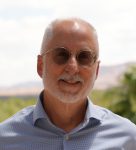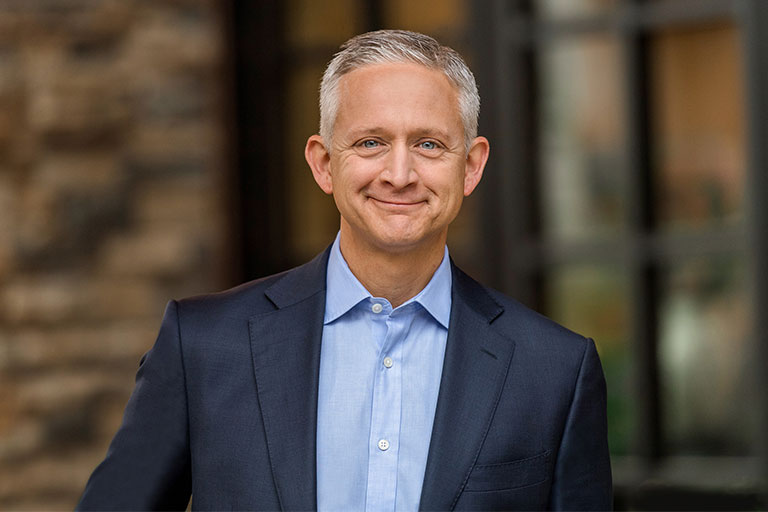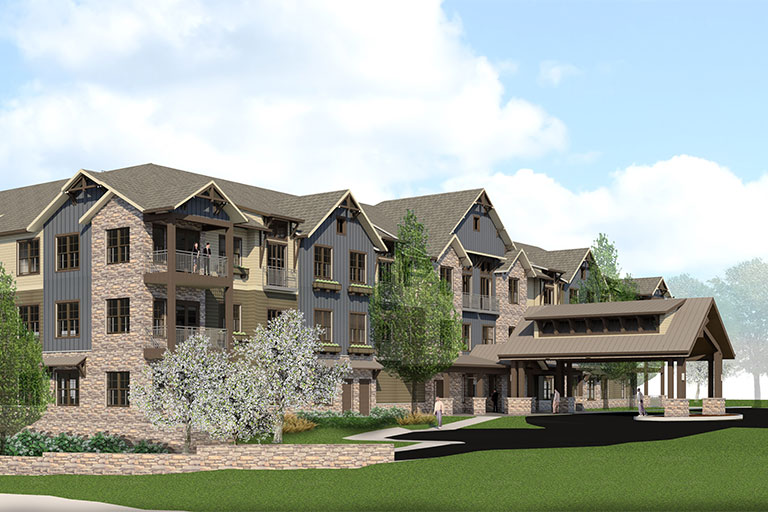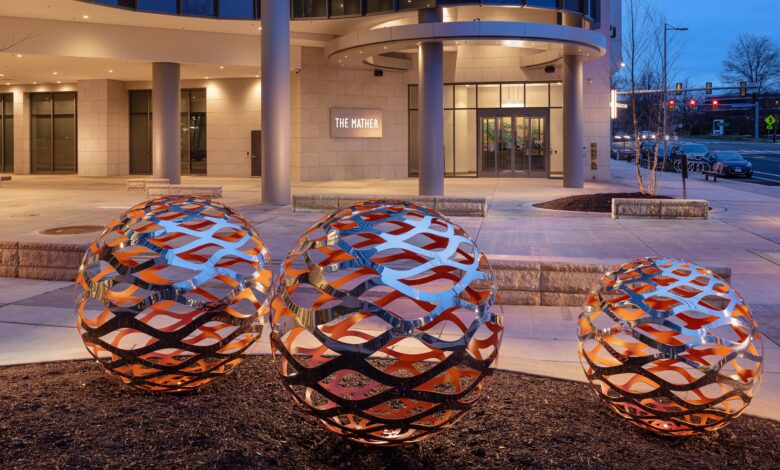
The CEO Series: Mather’s Mary Leary, Pt. 1
Celebrating One Year of The Mather in Tysons, Virginia
By Jim Nelson | March 26, 2025
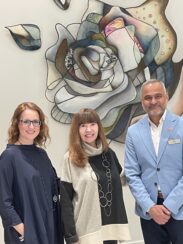
As you enter the downstairs foyer, before you even get on the elevator to go up into the newest Mather community — a 62+ luxury CCRC in Tysons, Virginia — you’re welcomed by a grand, commissioned piece of wall art. Then, when you step into the elevator, unbeknownst to you, you’re benefitting from an independent germicidal air purification system.
Welcome to The Mather in Tysons, which is celebrating its one-year anniversary this month.
The community includes 293 apartment residences on nearly four acres; the open floor plans range from 850 to 3,300 square feet, with floor-to-ceiling windows; high-end finishes and innovative smart-home technology are the standard. In addition to assisted living, memory support, and skilled nursing, an array of rehabilitation services, including physical, occupational, and speech, are onsite in their Life Centre, which opens in May.
When we arrived at The Mather, CEO Mary Leary was waiting for us along with GM Raj Radke to give us a personally guided tour of their new community. Throughout our day in the new Mather, we spent time learning about many of its features, for which we are deeply grateful to Mather SVP of Strategic Initiatives Meredith Boyle, AVP of Restaurant Operations Thad Parton, and AVP of Wellness Strategies William Myers, along with The Mather Tysons Director of Resident Engagement Jena Olsen, Spa and Fitness Manager Melinda Moore, Restaurant Manager Miloud Elattaoui, Beverage Manager Chris Hyman, and Director of Sales Kristina Pare. And a special thank you to Mather VP of Marketing Paula Ledbetter for coordinating our trip and helping with everything along the way.
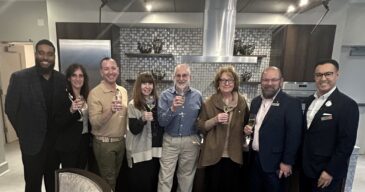
Mather, founded in Illinois in 1941 by Alonzo Mather, is a nondenominational nonprofit organization with its first two communities in Chicagoland and a third community on the outskirts of Tucson, Arizona. The Washington, D.C., area was chosen for its fourth community after a nationwide search of urban markets showed it to be “a deep, underserved market with numerous entrance-fee life plan communities reflecting a strong market, education, and acceptance of the life plan community concept” according to Leary. Mather’s leadership team was already quite familiar with the area; Leary herself once lived in Northern Virginia, while Baltimore, Maryland, was the childhood home of SVP of Sales Gale Morgan and Boyle’s current home.
In part 2 of our exclusive interview with Mary Leary we’ll spotlight some of the features and amenities that help The Mather stand out; for part 1, we’ll focus on the nuts and bolts, the how-they-pulled-it-off details.
SENIOR LIVING NEWS: You were already working on The Mather in Tysons when COVID hit; when did you start the process?
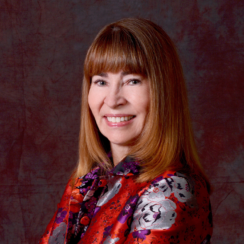
MARY LEARY: We started looking at sites in the Tysons area in 2012. We settled on this particular location and negotiated a purchase and sale agreement with the landowner in early 2017. We then pursued county entitlements approvals, receiving those in mid-2019.
During that process, we received our first unsolicited $1,000 deposit, and we continued to collect those as we went through the entitlements process. Then we began the formal conversion process to 10 percent deposits once we received entitlements approvals. We achieved 70 percent of apartment homes presold with 10 percent deposits in September of 2020. So, we were in the pandemic when we achieved that milestone, which was required by lenders to secure financing.
SLN: The Mather is a 50/50 equity partnership with real estate investment firm Westminster Capital. Who else did you partner with for the build?
ML: We worked with Huntington Bank and Truist, who served as co-leads for our construction financing. We ended up syndicating the loan and attracting a total of 10 banks. We achieved our financing goal in late 2021. Obtaining financing was a huge issue for senior living developers during the pandemic, and it’s still a challenge, so [we were] very fortunate.
Solomon Cordwell Buenz was our architect; they worked with us on the design of all our Mather communities. We worked with Bonnie Manson and Studio 121 on the interior design, and I’d just like to give a shout-out to Bonnie; I worked with her on projects dating back to the early ’90s, and she really is a legend in the industry. The Mather Tysons was her last project, as she passed away last summer. It warms my heart that she was a designer on that project. Bonnie and Rachelle DeGeorge, who is the president of Studio 121, worked very closely together on that. Whiting-Turner was our general contractor who built the community.
SLN: So, COVID comes along, and all the predictable obstacles suddenly get amplified in ways that you couldn’t have anticipated. How did you maneuver through that?
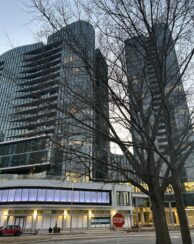 ML: We never anticipated that we would conduct our sales process virtually. Making a sale for an entrance-fee life plan community requires developing a strong relationship with people that is typically many years in the making, and we never envisioned developing these relationships on Zoom or meeting on someone’s outdoor porch while being masked. Fortunately, we had already converted all of our sales and marketing materials to digital, so we were able to transition to Zoom very easily. We had all of our sales tools at the ready to be able to walk people through what we were proposing. We started to come back to the sales center mid-2021.
ML: We never anticipated that we would conduct our sales process virtually. Making a sale for an entrance-fee life plan community requires developing a strong relationship with people that is typically many years in the making, and we never envisioned developing these relationships on Zoom or meeting on someone’s outdoor porch while being masked. Fortunately, we had already converted all of our sales and marketing materials to digital, so we were able to transition to Zoom very easily. We had all of our sales tools at the ready to be able to walk people through what we were proposing. We started to come back to the sales center mid-2021.
Financing, again, was an incredible obstacle. I’ve actually had other developers call me to find out how we did it. I know of one large project that was able to be financed after we had a conversation. We had developed strong relationships with lenders; that made it easier. Lenders became more hesitant regarding the amount they would loan relative to total project costs, so we ended up having to identify more lenders than normal. We also needed to identify an additional source of financing, since the banks had a cap on the amount they were willing to finance, and as a result Mather pursued an inaugural taxable bond financing and then Mather loaned funds to the project as a form of sub-debt. That was a creative approach to achieve the capital stack required to cover the full cost to build the community. We were required to repay $25 million by the end of December of ’24 relative to our construction financing; instead, we paid all $300 million back in October. I would consider that a home run. And the project repaid the majority of the sub-debt that I just mentioned.
Two other quick points in terms of the impact of COVID on building a large community like this. Construction is one job you can’t do virtually, right? We were fortunate that our general contractor had a strong presence in the D.C. area, and they were able to pull workers from around the region. At one point in July of ’23 they had 700 workers onsite on a daily basis. Also, entering into a guaranteed maximum price contract with the contractor early helped protect us from costs related to supply-chain disruptions and inflation, which we hadn’t anticipated.
I noticed that during COVID interior design product innovation was curtailed. I wasn’t seeing a lot of new products come on the market in terms of new styles of furniture or fabrics or art, so we had to work really hard to come up with something that was unique. One of the most unique aspects of The Mather is the curated, commissioned art and the installation of historic artifacts. So, we created our own innovation.
SLN: Your local director of sales, Kristina Pare, must have been doing a great job through all this because you achieved 70 percent presold with 10 percent deposits three and a half years before you opened.
ML: You’re correct. Kristina led our sales team to exceptional results through a variety of tactics which included successful virtual selling. We were also fortunate to have the necessary materials to help people kick the tires from a virtual standpoint. One thing that I was thinking about recently is that the pandemic — which caused people to be separated from other people — led to people who were considering a move to The Mather to really embrace a sense of community. They were yearning for the opportunity to develop strong relationships with people, which was so challenging during the pandemic. As a result, a number of depositor interest groups formed very naturally during the sales process; we had a hiking group that formed, and they would go to the Shenandoahs and hike the trails; we had a creative arts group that would get together virtually; we had a travel group that got together virtually. They formed really strong bonds during the presales period and as a result we didn’t see many cancelations.
SLN: That’s great to hear. How does the entrance fee work at The Mather in Tysons?
ML: Residents pay an upfront refundable entrance fee, along with an ongoing monthly service fee. Our model results in people receiving 90 percent or more of their entrance fee back when they move out or when they pass away. The Mather is unique among many life plan communities in that we commit to providing that refund within a certain period of time so they know that they or their family members will receive that; in the case of Tysons, it’s the earlier of when a new resident moves into their apartment, or a maximum of six months. That, I think, has been a strong selling point for prospects.
Additionally, residents pay an ongoing monthly service fee, and they have a choice of two healthcare plans. We call one the Life Care Plan or the Life Care Benefit, which we see as a form of prepaid long-term care insurance; if a resident moves to a higher level of living — assisted living, memory support, or skilled nursing — they won’t pay anything more than they were paying if they had remained in their apartment home.
The other plan is the 90-Day Benefit: if someone moves to a higher level of living [during] their first 90 days in the health center, they pay the same rate as they were paying if they had remained in their home; after 90 days, they start paying the market rate. This second option is actually attractive to those who may already have long-term care insurance.
